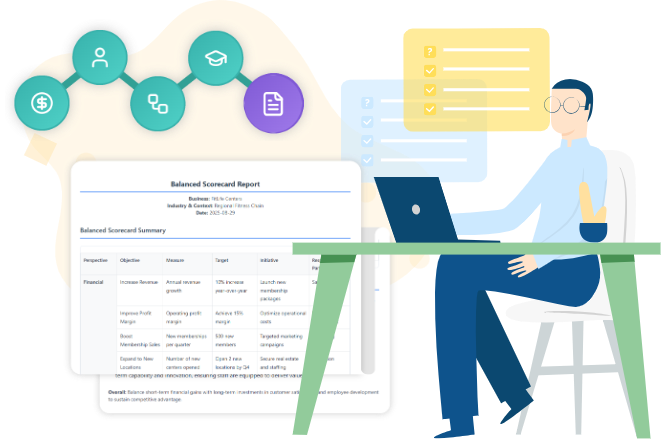How Our Balanced Scorecard App Works

What is a Balanced Scorecard?
The Balanced Scorecard is a powerful strategic framework. It helps you balance financial goals with the non-financial drivers of future success. Instead of just focusing on profit, it encourages you to look at your organization from four key perspectives:

Financial
How do we look to our shareholders (e.g., revenue, profitability)
REASON: To track the organization’s financial health and ensure its long-term viability.

Customer
How do our customers see us?
(e.g., satisfaction, market share)
REASON: To understand what drives customer loyalty and acquisition, which are key to sustainable revenue.

Internal Processes
What processes must we excel at? (e.g., operational efficiency, product quality)
REASON: To identify and optimize the core processes that create value for customers and shareholders.

Learning and Growth
How can we sustain our ability to change and improve? (e.g., employee skills, technology)
REASON: To invest in the people and technology that will drive future innovation and strategic success.
Where Does the Information Come From?
A balanced scorecard is not created in a vacuum. It is built on a foundation of solid data and thoughtful analysis from a variety of sources. The information you will input into the app comes from two main categories: internal business data and collaborative insights.
Internal Data Sources
Financial reports (balance sheets, income statements)
Operational dashboards (production numbers, service times)
Human resources data (employee satisfaction surveys, training completion rates)
Customer relationship management (CRM) systems
Collaborative Insights
Brainstorming and workshop sessions with key stakeholders
Interviews with department heads and team leaders
Direct customer and employee feedback sessions
Competitive analysis and market research
To build a truly effective scorecard, focus on collecting actionable data that directly relates to your strategic goals. Be sure to involve a diverse group of people from across the organization to get a holistic view. Regular review cycles are also essential to keep your scorecard relevant.
The Strategic Workflow
From Idea to Outcome
Our app is designed to follow a logical, step-by-step process. The app is the repository for your strategic thinking, not the starting point.
01 Initiate & Collaborate
Bring your team together for workshops to define your vision and mission. Brainstorm key strategic questions for each perspective to gather raw data and ideas for your scorecard.
02 Document & Analyze
Use our app to document your findings. Define strategic objectives, list Key Performance Indicators (KPIs), and outline initiatives in the app’s structured tables.
03 Visualize & Deliver
The app generates a single-page report that visualizes your strategy map. This report shows the cause-and-effect relationships between goals, making it easy to communicate your strategy.
The Value You Will Gain
Implementing a Balanced Scorecard provides tangible benefits that drive strategic success.

Clarity & Alignment
Your team will understand not just what they are doing, but why they are doing it. The app translates a high-level vision into actionable, measurable goals.

Holistic Perspective
You will move beyond a purely financial view and consider the critical factors that drive long-term value, such as customer satisfaction and employee capabilities.

Actionable Insights
The final report provides a clear roadmap. You will be able to see how improving one area (like employee skills) directly impacts others (like customer satisfaction and, ultimately, financial performance).
Frequently Asked Questions
Is the Balanced Scorecard only for large corporations?
No, the Balanced Scorecard is a flexible framework that can be used by any organization, regardless of size or sector. It is used by small businesses, non-profits, and government agencies to align their activities with their strategic goals.
What is the difference between a KPI and a strategic objective?
A strategic objective is a high-level goal, such as “increase customer satisfaction.” A KPI (Key Performance Indicator) is a specific, measurable metric used to track progress toward that objective, like “Net Promoter Score (NPS)” or “customer retention rate.”
How often should we update our Balanced Scorecard?
The scorecard should be a living document, not a one-time project. It is best to review and update your scorecard regularly, such as on a quarterly or semi-annual basis, to ensure it remains relevant and aligned with your evolving strategy and market conditions.
What is a Strategy Map?
A Strategy Map is a visual tool that illustrates the cause-and-effect relationships between your strategic objectives across the four perspectives. It shows how improving a process in one area (e.g., Learning and Growth) will lead to positive outcomes in other areas (e.g., Financial). The scorecard itself then translates this map into specific measures and initiatives.
Ready to Build Your Strategic Framework?
Start aligning your strategy and operations today. No sign-up required.

